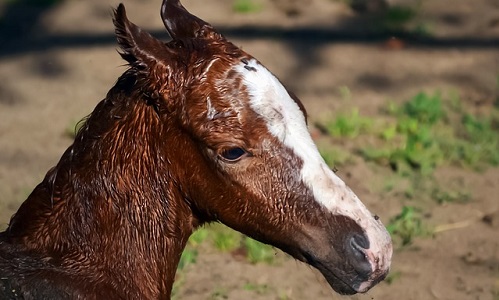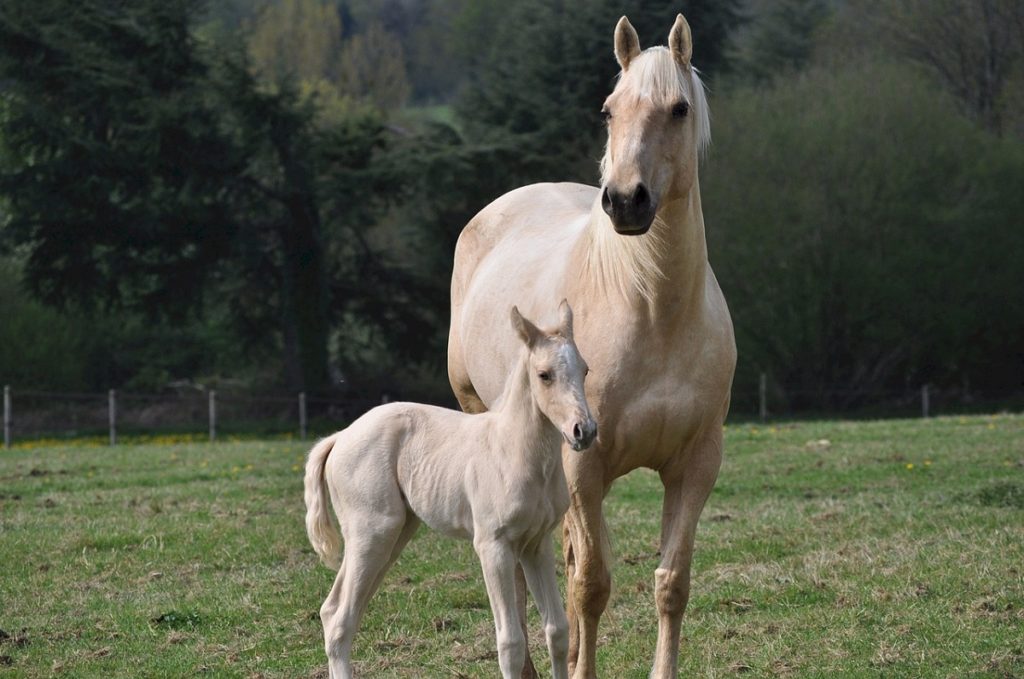Considering breeding your mare? Maybe you love your mare dearly, and she’s a dream to ride with a sweet temperament, and you can imagine having another little filly just like her someday. Or perhaps she’s from a strong lineage and you want to continue her line and plan for the future. Or, maybe you just really love the old girl, and you want to breed her before she hits retirement age and you lose the opportunity.
Whatever your reasons for breeding, you should never undertake the endeavor lightly. With that said, here is a short, helpful guide to horse pregnancy. While this guide is by no means exhaustive, it is a great starting point for understanding pregnancy of a horse.
Breeding Considerations
Breeding a mare is costly, both in terms of cash and time, never mind the emotional investment and expertise required to do so successfully. Breeding any animal is a commitment and horses aren’t any different. You should always think in terms of the future and what might happen to your horses if you’re not around or your attention is diverted to other things of equal or greater importance. You also shouldn’t attempt breeding your mare if you anticipate any big life changes in the next few years. Wait until the time is right and you know you’re fully committed.
The next thing you need to consider is the health of your mare. How old is she? Is she of healthy weight with no concerning medical conditions? You don’t want to breed a mare too early although they can be bred as old as 18 months of age. But ideally, you should try to wait until they are at least 4 years old, if not longer. Mares can be bred for quite a long time, so there isn’t any rush. They can safely carry a foal to term all the way into their late 20’s if they are in good health and physical condition. Additionally, if a mare is undernourished or underweight, she will find it harder to conceive. If she does conceive, it will be harder for her to carry the foal to term and the pregnancy may spontaneously abort.
Consider the time of year you want your mare to foal and where you live. It’s much better for a mare to begin labor during warmer months than trying to foal in the middle of winter, especially if you live somewhere with colder climates and/or snow. So, choose when you breed your mare carefully and take your facilities, the level of available care you have, and the timeline into consideration beforehand.
What to Expect When Your Horse is Expecting
Horses aren’t that different from any other mammal, or people for that matter. They conceive and carry a baby to term much like we do, with similar hormonal and physical changes that occur from week to week.
 Knowing exactly how long your horse will be pregnant is not easy. A healthy gestation period for a mare to produce a foal can vary in length. Some pregnancies can take as little as 315 days all the way up to 370 days or more. The average gestation period will range somewhere in between 326 to 354 days, or roughly 11 months. Those 11 months can be broken into three trimesters, with conception happening at the start of the first trimester and foaling happening at the end of the third trimester.
Knowing exactly how long your horse will be pregnant is not easy. A healthy gestation period for a mare to produce a foal can vary in length. Some pregnancies can take as little as 315 days all the way up to 370 days or more. The average gestation period will range somewhere in between 326 to 354 days, or roughly 11 months. Those 11 months can be broken into three trimesters, with conception happening at the start of the first trimester and foaling happening at the end of the third trimester.
Some mares just carry a foal longer than others and they may do so with every foal they produce, even carrying them a year or more. Additionally, seasonal factors can affect the length of gestation due to something called photoperiod. Photoperiod is the amount of time your horse is exposed to sunlight. Mares exposed to longer days such as those bred during the spring and summer, will have a shorter gestation period than mares who conceive and are planned to foal earlier in the year. The interesting thing about mares is that despite the long gestation period, you don’t have to change much in the way of behavior and habits, such as riding and exercise until the final 3 or 4 months of gestation. Until then, it’s largely business as usual.
Ultrasounds can detect pregnancy as early as two weeks after breeding your mare or about 5 days into gestation and are the preferred standard today. However, blood and urine tests may also be used at least 10 days or more after ovulation. Some vets can do a manual assessment of a mare and her uterus and detect a pregnancy that way, but the mare has to be at least 6 weeks along before that is possible.
The first trimester begins at conception and ends around day 113 of the gestation period. During the first trimester, you will need to confirm your mare’s pregnancy, using either a blood or urine test or an ultrasound. Vaccinations and deworming should continue as normal. This is the time that your vet will check for twins as well, and if necessary remove one of the embryos. Twins create a lot of unnecessary risk to the mare and usually aren’t viable pregnancies.
Twins that do manage to make it through full gestation are smaller and weaker and often don’t live past two weeks. So, it is safer and healthier for both the mare and the foal for any twin embryos to be separated before it becomes a problem. It is also during the first trimester of your mare’s pregnancy that amazing fetal development occurs, with the heartbeat appearing around day 25 and features like the foal’s tail and hooves becoming recognizable sometime between days 20 to 40.
The second trimester begins around day 114 and ends about day 225. During this stage, the foal still develops but doesn’t undergo any drastic changes in size. This is the period of time the sex is often discovered, usually between the 5th and 6th month of gestation. During these first two trimesters, you can still feed your mare the same as you normally would, and ride and exercise her like you normally would.
Once you move into the third trimester, roughly starting on day 226, you’ll need to start preparing for foaling, as well as ease off on the exercise, increase her feed, and move her to her own special space. Sharing a pasture or paddock with other horses can trigger aggression that could accidentally harm the baby, so it’s better to keep your mare confined somewhere that she can roam and graze but not get into too much trouble.
The third trimester is where you will really begin to see your mare’s belly grow in size and she will become more sluggish and less active. The third trimester is usually when you can see visible signs your horse is pregnant. Sometimes you will notice your mare’s belly “drop” when the abdomen muscles relax and begin to sag. This is often more noticeable in older mares, but you can see it with younger ones as well. You will also see your girl’s udders and teats begin to swell and when you’re really close to foaling, they will begin to secrete a clear liquid. Usually, around 2 days before foaling happens, the liquid will turn from clear to milky white and thick, coating the teat in a process called “waxing.”
Other changes happen during this period too, all preparing your mare for the upcoming big reveal.
Feeding Your Mare While Pregnant
It’s important to feed your mare a healthy, well-balanced diet while pregnant, but you should never overfeed them. A good rule of thumb is to feed your mare just as you normally would until about 6 weeks before foaling is expected. The 6 weeks before birth and the 6 weeks after birth are the most taxing on your mare and are the times she will need extra nutrition the most.
 The goal is to have your mare at a nice, healthy weight before breeding and for her to stay that way throughout the gestation period. Horses that are underweight can have problems conceiving and carrying their foal, and a pregnant horse that is overweight or gains a significant amount of weight while pregnant are equally at risk for detrimental health conditions like horse laminitis or fatty deposits in the pelvis.
The goal is to have your mare at a nice, healthy weight before breeding and for her to stay that way throughout the gestation period. Horses that are underweight can have problems conceiving and carrying their foal, and a pregnant horse that is overweight or gains a significant amount of weight while pregnant are equally at risk for detrimental health conditions like horse laminitis or fatty deposits in the pelvis.
Your mare also needs to have access to plenty of grazing material and roughage. If you don’t have a lot of grass and pasture, make sure she has bales of hay throughout the day to munch on. The roughage helps to prevent digestive issues like colic or stomach ulcers. She should also have free access to clean water, preferably not stagnant water. Mares can pick up harmful bacteria from stagnant water and possibly abort because of it. Fresh, clean, running water is ideal.
Be Prepared!
Create a foaling kit to have on hand for the big day. Some things you might include in your foaling kit are:
- Betadine scrub
- Iodine and dip cup
- A stethoscope
- A thermometer
- Sterile knife or scalpel
- Batteries
- Flashlight or lantern
- Self-adhesive and/or cotton tail wrap
- Rolled cotton
- KY jelly
- Lots of clean towels (cotton)
- Large garbage bags
- Long-sleeved OB gloves
- A clean water bucket
- Bucket for placenta
- Ivory soap and handy wipes
- Bailing twine
- Foal enema
When your mare is gearing up to foal and begins to feel contractions, you will start to notice certain behaviors, like restlessness, getting up and down a lot, looking back at her flank, and even eliminating feces in small amounts. It’s almost like she’s nervous or colicky, but it’s due to contractions, not an illness. Her water may or may not have broken already, but if it hasn’t, it will soon.
Once it does, the mare moves into the second stage of foaling, where the foal is now in the birth canal and ready to emerge with her pushes. During this time the mare will lie on her side and push until the foal is delivered. This second half of the foaling process should only take about 20 minutes, it moves fast. If it takes much longer than 40 minutes or it seems as though your mare is in distress or not making much progress, call your vet if they aren’t already there.
Once the foal is born the mare will expel the placenta not long after, usually within the first half hour. Sometimes it can take longer but should never take more than 3 hours. Also, never try to assist in pulling the placenta out. If a piece is torn and gets left behind, it can make your mare extremely ill. Use the bailing twine to tie the placenta up over her hocks if you are concerned she will rip it herself. Again, if this process doesn’t seem to be occurring on the timeline that it should, seek help from your vet.
Once your foal is born, make sure you dip the umbilical cord in a bit of diluted iodine once it breaks to prevent infection. Your colt or filly should begin standing or trying to stand within an hour or so of arrival and start nursing soon after to get plenty of colostrum. Your foal needs that colostrum to help protect their immune system in their first days of life.
Once the foal is born, have your vet check both mama and baby so they can have a clean bill of health. Then you can sit back and enjoy your new horse family.
Sources:
Thal, Doug. “The Late Term Pregnant Mare, Foaling & Newborn Foal Care.” Horse Side Vet Guide, 1 Sept. 2016, Accessed 20 Oct. 2018. www.horsesidevetguide.com/drv/Topic/196/the-late-term-pregnant-mare-foaling-amp-newborn-foal-care/.
O’Brian, Anna. “What to Expect When Your Mare Is Expecting.” PetMD, Accessed 20 Oct. 2018. www.petmd.com/blogs/thedailyvet/aobrien/2013/june/what-to-expect-when-your-mare-is-expecting-30470.
“Expectant Mare: Assuring the Health and Well-Being of the Pregnant Mare.” American Association of Equine Practitioners, Accessed 20 OCt. 2018. www.aaep.org/horsehealth/expectant-mare-assuring-health-and-well-being-pregnant-mare.
Davis, Jen. “Pregnancy Stages in Horses.” Animals – Mom.me, 11 Aug. 2017, Accessed 20 Oct. 2018. www.animals.mom.me/pregnancy-stages-in-horses-2717727.html.
Smith, Donna. “Signs and Stages of Pregnancy in a Mare.” PetHelpful, 26 Dec. 2016, Accessed 20 Oct. 2018. www.pethelpful.com/horses/Signs-and-Stages-of-Pregnancy-in-the-Mare.
“Managing Pregnant Mares – The Horse.” The Horse, 12 Feb. 2018, Accessed 20 Oct. 2018. www.thehorse.com/113249/managing-pregnant-mares/.
Thal, Doug. “The Late Term Pregnant Mare, Foaling & Newborn Foal Care.” Horse Side Vet Guide, 1 Sept. 2016, Accessed 20 Oct. 2018. www.horsesidevetguide.com/drv/Topic/196/the-late-term-pregnant-mare-foaling-amp-newborn-foal-care/.
O’Brian, Anna. “What to Expect When Your Mare Is Expecting.” PetMD, Accessed 20 Oct. 2018. www.petmd.com/blogs/thedailyvet/aobrien/2013/june/what-to-expect-when-your-mare-is-expecting-30470.
“Expectant Mare: Assuring the Health and Well-Being of the Pregnant Mare.” American Association of Equine Practitioners, Accessed 20 Oct. 2018. www.aaep.org/horsehealth/expectant-mare-assuring-health-and-well-being-pregnant-mare.
Davis, Jen. “Pregnancy Stages in Horses.” Animals – Mom.me, 11 Aug. 2017, Accessed 20 Oct. 2018. www.animals.mom.me/pregnancy-stages-in-horses-2717727.html.
Smith, Donna. “Signs and Stages of Pregnancy in a Mare.” PetHelpful, 26 Dec. 2016, Accessed 20 Oct. 2018. www.pethelpful.com/horses/Signs-and-Stages-of-Pregnancy-in-the-Mare.
“Managing Pregnant Mares – The Horse.” The Horse, 12 Feb. 2018, Accessed 20 Oct. 2018. www.thehorse.com/113249/managing-pregnant-mares/.




